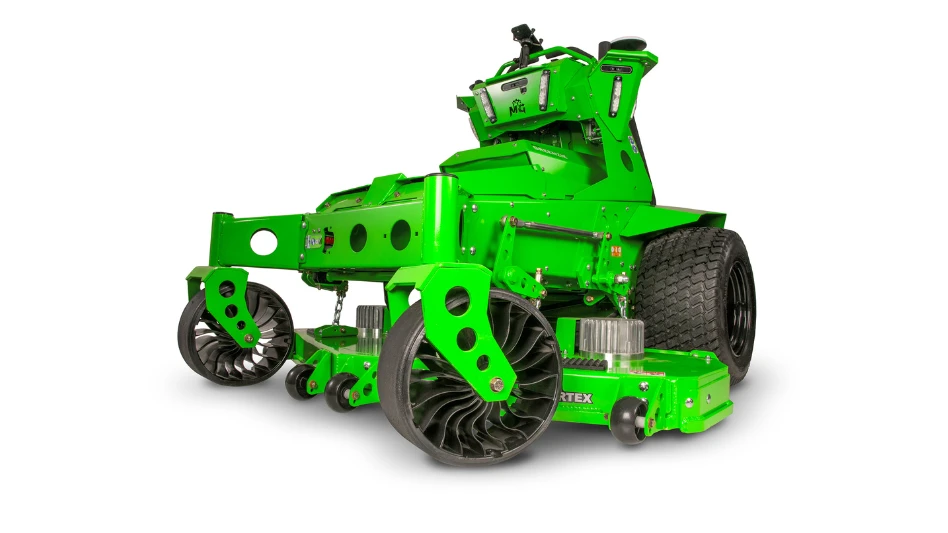Annual turf packages, which typically consist of six to seven applications, including pre-emergents, fertilizer and insect control, are a staple for LCOs. “Fall is the ideal time to renovate turf,” says Jim Foglio, president of Lasting Impressions Landscaping in Stroudsburg, Pennsylvania. “About 10% of our customers opt for fall packages such as aeration and overseeding, which has a huge impact for next year.”
Many companies admit that fall turf services are not necessarily a huge moneymaker, mostly because not every client opts for them. But they are still an essential part of the lineup of total turf care offerings. “Services such as aeration may provide only a small profit, but it’s more a benefit to customer retention,” says Brian Ethridge, chief technology officer with Waynes Environmental Services, based in Birmingham, Alabama and Nashville, Tennessee.
“Your customers expect the service, especially for cool season grasses, and healthy lawns lead to customer loyalty and word-of-mouth referrals, which are huge in this business sector.”
While annual chemical treatments typically range from $5 to $10 per thousand square feet of application, services for fall turf care like aeration and reseeding usually are priced at 1.5 to 2.5 times that rate, LCOs say. Pricing also may increase depending on the complexity of the property, such as slopes or the number of gates.
Generally, the companies we spoke to for this article realize a 30 to 40 % profit margin from fall turf services.
Build in additional services.
Working fall care into your packages is a simple way of selling long-term turf health to existing contracts. For example, it’s prudent to add a fall soil testing service or a lime application to maintain soil pH as the last service of the season. Improved turf performance also keeps customers coming back year after year. “We are constantly studying what works or doesn’t,” Ethridge says. “Our mindset is that our customers are not buying applications, but rather 365 days of full-service lawn care program.”
A few companies offer a la carte turf services in autumn.
“You do occasionally get someone calling in the fall to ask if you can do anything to help their lawns,” says Erik Sweetser, president of Green Grass Lawn Care in North Hampton, New Hampshire.
“But it’s not that common. The majority of our clients opt for the annual package starting in the spring.”
Educate your clients.
It’s no use trying to sell a service your clients don’t understand. Stay up to date on turf care, and be generous about sharing your knowledge with customers. Blog, send out email newsletters and include information with billing statements. “Explain how fall work such as aeration benefits lawns now and in the future,” Foglio says.
“Teach customers that although we start improving the soil now, it will take a full season to see the effects of our efforts.”
In addition, instruct customers on how to water properly so they’re partners in working with you, not inadvertently against you, to build healthy turf that’s more resistant to stressors.
Educate your technicians.
Make sure your employees inspect turf before any product application. “We walk every lawn and look for disease, weeds and signs of insect activity prior to service,” Ethridge says.
Identifying potential problems such as thinning areas also yields an opportunity for selling services such as fall renovation that will benefit the turf health and appearance in the long-run.
Offer renovation services.
Most lawns benefit from regular aeration. Aeration improves soil impaction, reduces thatch and creates pores from the removal of soil plugs through which moisture or plant nutrients are absorbed by the soil.
“We always recommend aeration and overseeding when a lawn begins to decline,” says Linda Smith, owner of Progressive Lawn Managers in the Greater St. Louis area. “But ideally, it should be done annually.”
It’s also essential to tailor the service to the individual property. “It’s not one-size-fits-all,” Foglio says. “For example, overseeding can be lucrative, but you have to look at that specific lawn’s needs. Is it shade or sun? We don’t use the same seed for everyone. You’re not going to get good results or promote customer retention that way.”
Don’t forget that aeration should be done when grass is actively growing so it recovers quickly to fill in the openings in the turf left by the aerator.
That means fall is the ideal time for aeration of cool season grasses, which grow fast after emerging from summer stress. But warm season grasses should be aerated in spring or early summer, which is their period of active growth, Ethridge says.
Get the word out early.
Selling fall services starts early in the year. Technicians can leave information starting with the first application of the season.
Periodic email blasts, social media and notes on the bottom of electronic billing remind customers of the importance of preparing their lawns for winter.
Some companies do direct mailers or offer discounts on annual packages to new clients picked up during the fall push. The point is to get the word out repeatedly. “We make lots of mentions to keep the concept of year-round turf care ever-present in our customer’s minds,” Ethridge says.
The author is a freelance writer based in the Northeast.
Latest from Lawn & Landscape
- Connect, Control & Conserve with Horizon Technical Services
- Use Horizon's Parts Hotline
- How I built a Top 100 company
- Horizon’s Exclusive TurfGro Fertilizer
- Grow your business with mosquito control
- LandCare adds 2 branches in SoCal, promotes Aleman to branch manager
- Spray them away
- PERC helps debut propane direct-injection fuel system at ACT Expo 2025





